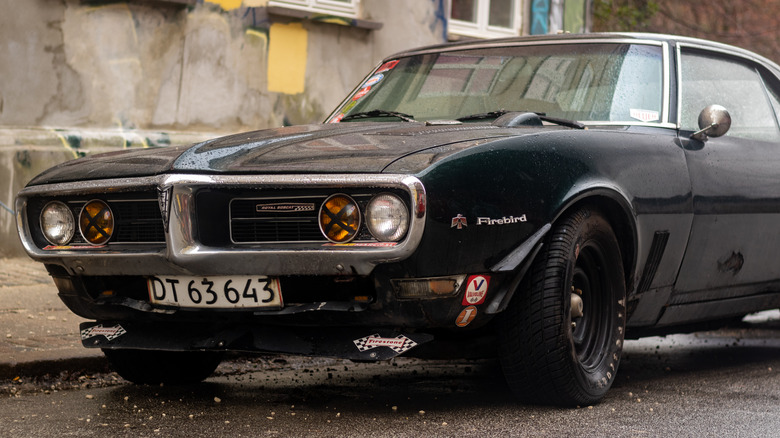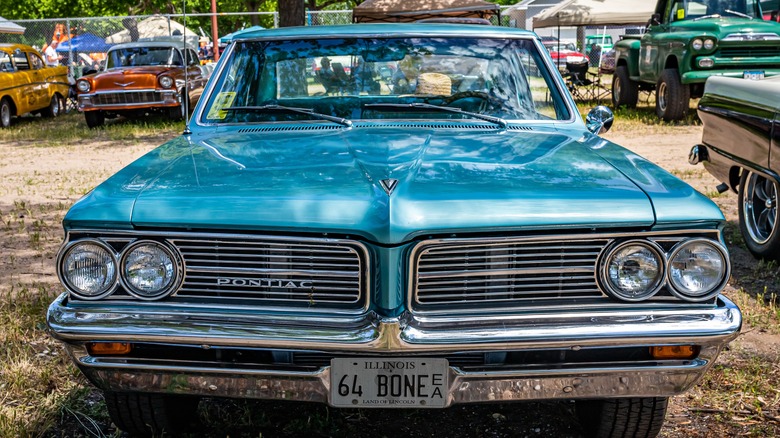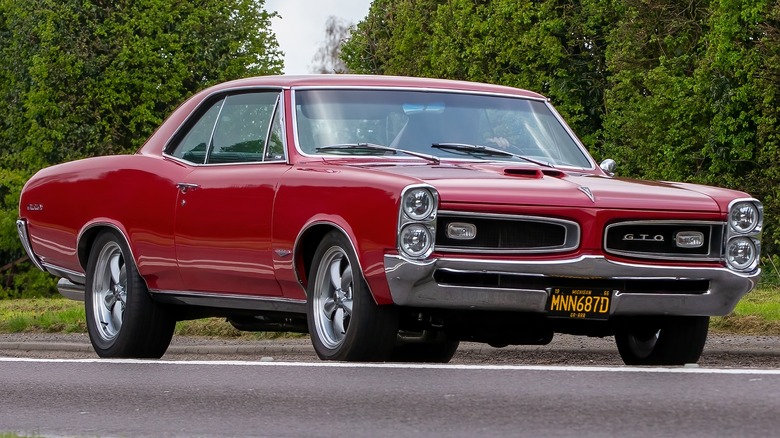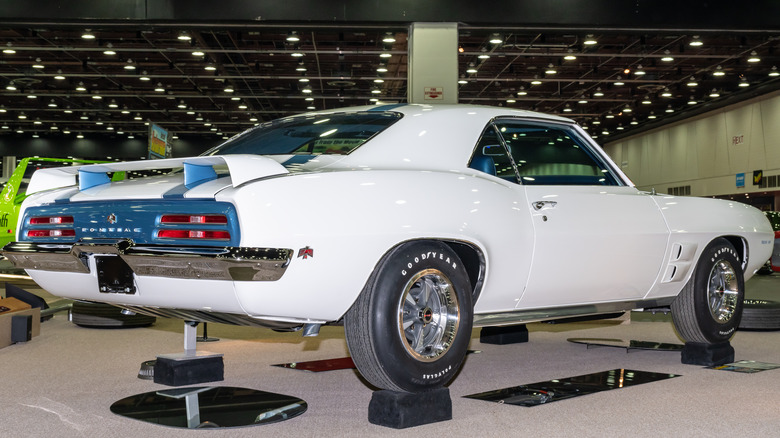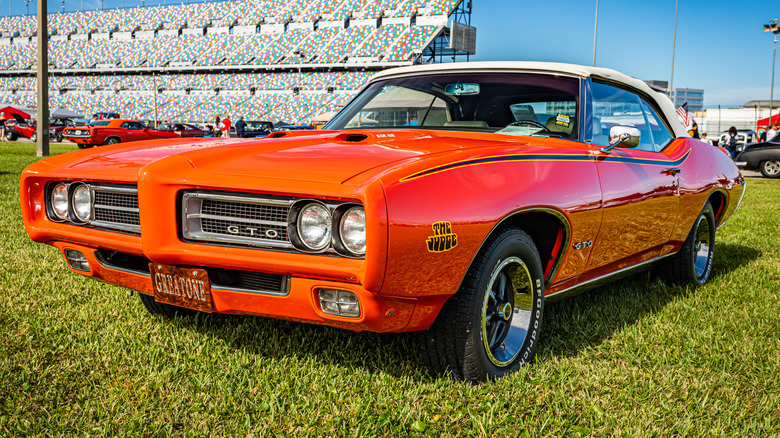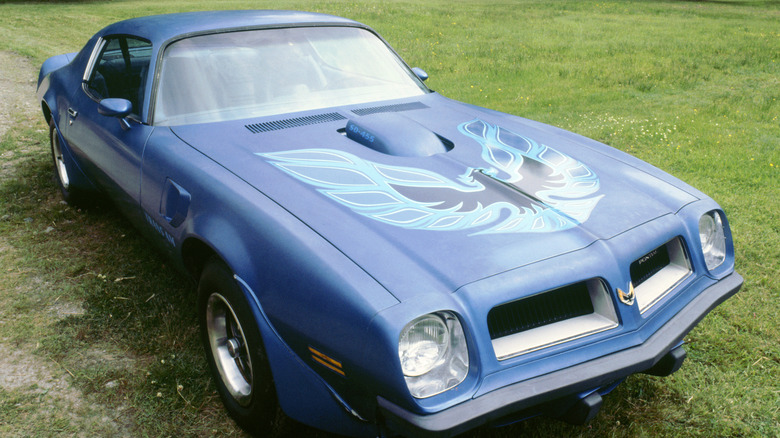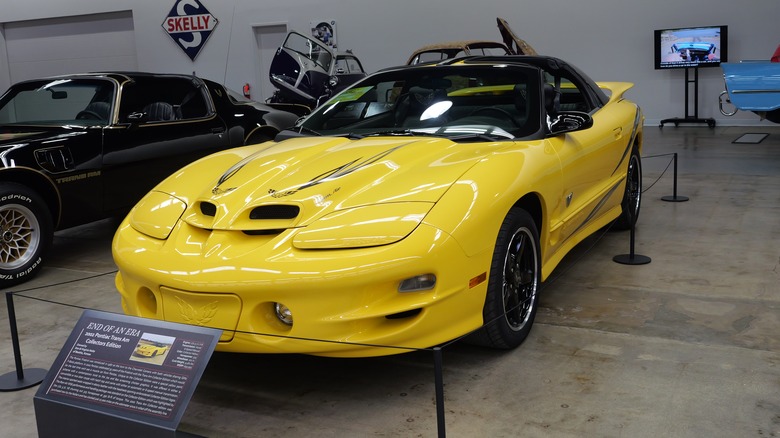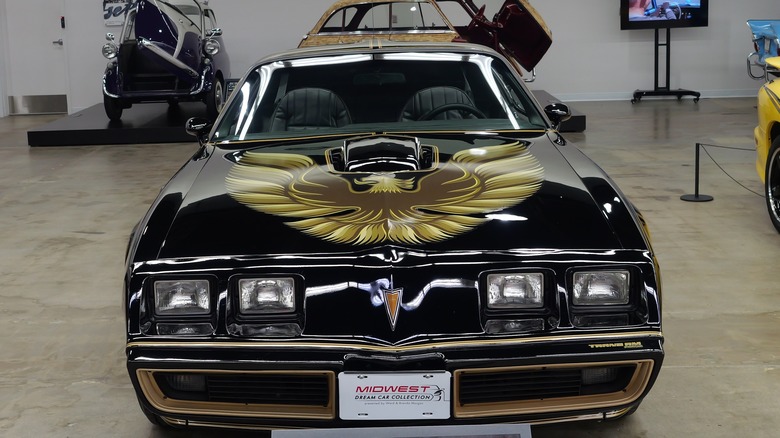7 Of The Most Iconic Pontiac Muscle Cars Ever Made, And What They're Worth Today
In the halcyon days of cheap, plentiful gas and nary a concern for environmental protection, Detroit pushed out some of the biggest and baddest cars to ever grace America's roadways. There was no replacement for displacement, and iconic cars paired with powerful big block engines sent car lovers into a frenzy. Even today, classic muscle cars remain in serious demand, and they aren't making any more of them.
The first generation, 1964-½ Ford Mustang, technically a pony car — a compact chassis with V8 power — kickstarted the American muscle craze. However, another company hit the scene just a little bit earlier. Pontiac, now defunct, first harnessed the desire for powerful engines in mid-sized cars just a half year earlier. While the Mustang began production halfway through 1964, Pontiac got the jump on it with perhaps the first true muscle car: the Pontiac Tempest.
Pontiac held its own through the golden age of muscle car production, churning out iconic models that more than kept up with the best offerings of the competition. Names like the Tempest, Trans Am, and GTO still make the mouths of gearheads everywhere water. Unfortunately, these original cars are only becoming more rare. With the scarcity comes the accompanying price hikes that make them just as pricey as they are desired. Join us as we take a look at some of Pontiac's most iconic muscle offerings and examine how much they're fetching on the market today.
1964 Pontiac Tempest GTO ($25,000 to $182,000)
As the 1950s ended, the Big Three automakers realized there was a demand for cars smaller than a battleship. Chrysler put forth the Valiant in 1959, then Ford and Chevrolet introduced the Falcon and the Corvair in 1960, respectively. Pontiac was last to join with the 1961 Tempest. Available in two- or four-door models, the Tempest had a four-cylinder engine. No one would suspect the unassuming vehicle would soon kick off a power race.
The second-generation Tempest debuted in 1964. Buyers could choose between three trims: the Series 20 (base trim), the Custom (mid-level), and the Le Mans (premium). All had the option for a V8 engine, but the Le Mans GTO package changed the world. The GTO, lifted from Ferrari's 250 GTO, stands for Gran Turismo Omolgato and denotes cars under limited production and certified for certain races.
The legendary 1964 Pontiac GTO had a 389 cubic-inch V8, making 348 horsepower. The trim's paradigm-shifting design proved that a fast car could also be comfortable, and it revolutionized American auto-making. Soon, the Big Three would outdo themselves to see who could put the most power under the hood of a mid-sized car.
The Tempest GTO is recognized today as a pivotal entry in car history. Collectors have shown significant interest in the historic vehicle. Prices range between $25,000 for base model Tempest projects to upwards of $182,000 for the legitimate and rare GTO package.
1966 Pontiac GTO ($22,000 to $184,000)
By 1966, the early stages of the muscle wars had warmed up. Ford had made a splash with the Mustang, Dodge charged into the fray with the Charger, and Chevrolet's debut of the Camaro was just around the bend in 1967. Pontiac decided to make the most of the GTO's panache by spinning the car off into its own vehicle. Available purely as a two-door, the 1966 GTO offered hardtop, convertible, and vinyl top roofs along with a myriad of options.
Built under the supervision of GM vice-president and Pontiac general manager John Delorean, the 1966 GTO came with a single engine option: Buyers got a 389 whether they liked it or not. The V8 made between 335 and 360 horsepower depending on the setup and came attached to a manual or Turbo Hydra-Matic automatic transmission. Pontiac built about 97,000 1966 GTOs, which went on to be the best-selling year the GTO ever had.
Today, the 1966 Pontiac GTO is a popular collector's item for lovers of the inaugural sports car. Low prices hover around the $22,000 range while the highest recorded sale of a normal '66 GTO is well into the six figures at nearly $184,000. Average examples are not yet into the astronomical level, with an average price of $59,896. Anyone who wants a true one-of-a-kind 1966 GTO will have to shell out nearly $400,000 for the "Monkeemobile" — a one-off Goat used for the "Monkees" television show.
1969 Pontiac Trans Am ($60,000 to $440,000)
As the muscle wars heated up, General Motors wanted something to compete head-to-head with the lighter Mustang. The newly designed Chevrolet Camaro and Pontiac Firebird hit the markets in 1967. Classified as pony cars rather than mid-sized muscle, both vehicles became instant classics. However, throwing a base model into the mix wasn't enough. The Camaro Z/28 performance package appeared in the first year of production. Firebird fans would have to wait until 1969 before Pontiac supplied the Trans Am.
Named after the Trans American race series, the first generation Pontiac Trans Am offered improved handling and suspension and upgraded cosmetics. A 400 cubic-inch, 355 horsepower L74 V8 with Pontiac's soon-to-be-legendary Ram Air induction. Brand-new buyers could choose between convertible or hardtop variants, but not color — every '69 Trans Am came in white with blue racing stripes. The package cost an extra $725 on top of the $2,831 price for the hardtop. The 1969 Trans Am is an exceedingly rare car; only 689 hardtops and eight convertibles were sold in the debut year.
With so few going out the door in 1969 and 1970, it's safe to assume that there just aren't many left today. Current values seem to affirm this theory. The average price for a true 1969 Trans Am is about $140,000, and finding one for under $60,000 will be a real challenge. The rarest of the rare, a 1969 Trans Am Ram Air IV sold in January 2023 for a whopping $440,000.
1969 GTO Judge ($83,000 to $240,000)
The Firebird wasn't the only Pontiac muscle car to get a performance model. The GTO approached the zenith of the muscle car era with sagging sales, and Pontiac wanted an attention-grabbing designation to remind a buyer base dazzled by a market flooded with Roadrunners, Mustangs, Camaros, Chargers, Challengers, and many other goodies. The GTO Judge started life on the drawing board with a 350 cubic-inch budget model for the drag strip, but engineers, at the behest of John Delorean, soon scrapped the budget talk.
The Judge rolled out the door with a 400 cubic-inch V8. Pontiac built a total of 6,833 GTO Judges, including 108 convertibles, for 1969. The base price for a GTO was $3,156 for the hardtop and $3,382 for the convertible. Buyers could shell out $332 for the Judge option and its Ram Air IV with 370 horsepower. The GTO Judge was one of the best outfitted muscle cars for a very reasonable price during the 1969 model year. However, while Pontiac sold about 72,000 GTOs in 1969, the interest in the Judge wasn't enough to prevent their slipping sales. The GTO would hang on until 1974 before going out of production as the muscle era came to an end.
Though the Judge failed to meet the hopes and expectations of Pontiac in terms of sales, models are highly sought-after collector's items today. The average cost of a '69 Judge will set potential buyers back to the tune of about $83,000 with a top price of $440,000. Most recently, a Judge went off the auction block for a cool $240,000.
1974 Trans Am SD 455 ($20,000 to $260,000)
It's impossible to talk about iconic Pontiac muscle without including a second-generation Trans Am. Something about that phoenix spreading its wings around a shaker hood calls up visions of jean jackets, wispy mustaches, Led Zeppelin blaring from the speakers, and rubber-burning power. The 1974 Trans Am SD 455 brings it all to the table.
The Clean Air Act of 1970 and growing concerns about the price of gasoline were slowly but surely putting nails in the coffin of the muscle era, but Pontiac held on as long as it could. The SD stands for Super Duty, former GM general manager Semom Knudsen's brainchild aimed at making Pontiac appealing to the youth by winning on the race track.
The 1974 Trans Am SD 455 came with a whopping big-block 455 cubic-inch engine (the largest of the muscle car era), supplying 310 horsepower and 395 lb-ft of torque. That particular engine was only offered in 1973 and 1974, the last years of the over-the-top, gas-guzzling beasts before the gradual shift to the underpowered '80s. Aficionados consider the '74 model one of the last true muscle cars. The late arrival of the SD 455 meant very few cars ever got one. They were hard to find even when new — only 1,000 came out of the factory in 1974.
Today, a second-generation SD 455 (1973 and 1974) is valued at nearly six figures, with an average price of $90,722 and a top sale of $260,000. Projects might be found for as little as $20,000, but the work required to restore one of these classics is considerable.
2002 Pontiac Trans Am WS6 ($5,500 to $112,000)
Pontiac emerged from the tragic '80s with rebounding power numbers and attractive styling, and by the line's last year in 2002, the WS6 was a powerful-handling Trans Am. The WS6 package dates back to 1978 when $324 bought a handling package including anti-sway bars, wider wheels, and an upgraded steering box. The original option took a hiatus between 1993 and 1995, returning for the '96 model year and sticking it out until the Firebird went out of production.
The last go-around of the Trans Am put a 320 horsepower, 345 lb-ft of torque5.7 L LS1 lifted from the C5 Corvette under a hood that looks like the face of a fire-breathing dragon. Paired with a Tremec six-speed manual or automatic option, there's no question that the final iteration of Pontiac's most beloved nameplate was made for performance.
Though plastic quality and cheap interiors are common complaints, the 2002 WS6 is a sneaky way into Trans Am ownership. The fourth-generation Trans Am is by far the most accessible Pontiac on this list. An average price of $25,734 and a top sale of $112,000 with a low of $5,500 indicates that these cars are around, just waiting for you to pick one up. It's nearly impossible to predict if a vehicle will be a future classic, but these fourth-generation Trans Ams may be the best way to get behind the wheel of a powerful piece of Pontiac history.
1976-1977 Pontiac Trans Am LE ($62,000 to $400,000)
Some cars become famous for their place in automotive history, some for their race-winning pedigree, some for performance, and some transcend all of that and make their place in pop culture. Steve McQueen's Bullitt Mustang, James Bond's Aston Martin DB5, and even Herbie the Love Bug have found wide appreciation not because they were great cars, but because they made their way into the pop culture lexicon through appearances in movies. This Pontiac muscle car enjoys the double distinction of being both genuinely cool and famous as the bootlegging bandit in 1977's "Smokey and the Bandit" starring Burt Reynolds.
Though the film depicts a 1977 Pontiac Trans Am being used to smuggle beer across the Texarkana border, the truth is at the time of filming the '77 model hadn't hit the streets yet. General Motors, eager to promote its cars, supplied the production with the new front-end parts of the soon-to-be-released 1977 model. The black and gold Trans Am LE became a representation of rubber-laying power and nose-thumbing anti-authority attitudes.
Outfitted with a 455 cubic-inch V8 and the 1970s most quintessential accessory, T-Tops, none of the unfortunate original Bandits survived filming, but Trans Am fans can replicate their favorite movie with their own 1977 Trans Am LE. Being an icon, they command a decent price on the used market, with the average cost being $62,370 and a top sale of $400,000. And that's before you spring for the black-and-gold repaint so you can channel your inner Burt Reynolds.
